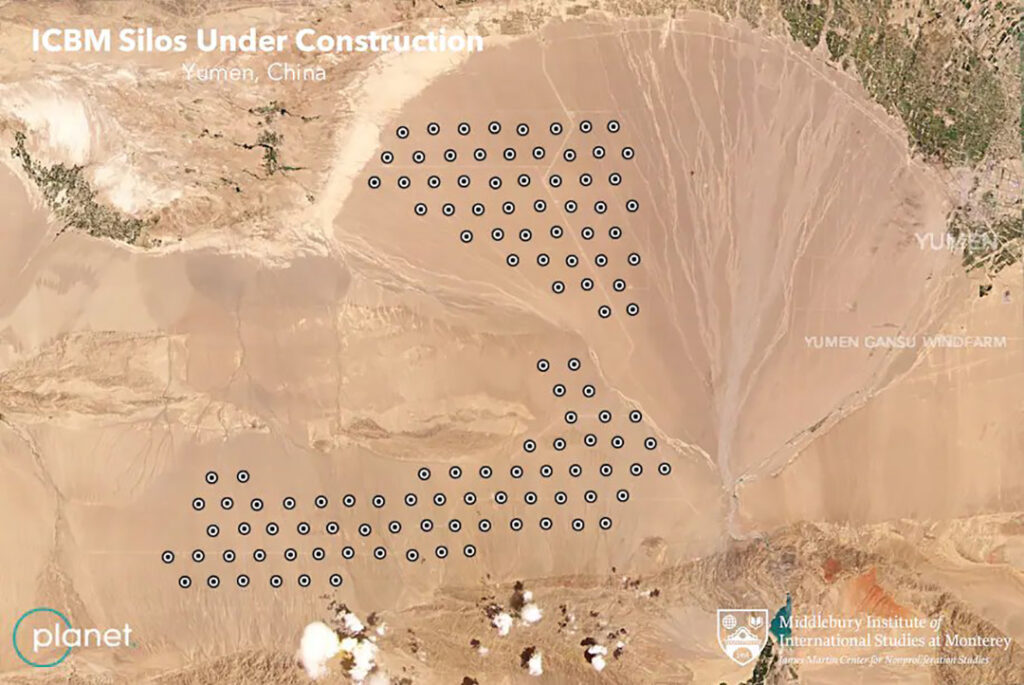Voice of America News
United States researchers using commercial satellite imagery said the People’s Republic of China (PRC) appears to be significantly expanding the number of launch silos for its arsenal of intercontinental ballistic missiles (ICBMs), raising fears that nuclear weapons will become a new issue of contention between Washington and Beijing.
Using images provided by the satellite imaging company Planet, two researchers from the James Martin Center for Nonproliferation Studies at the Middlebury Institute of International Studies in Monterey, California, discovered the PRC is building 119 silos in the desert of the northwestern province of Gansu.
Jeffrey Lewis, one of the researchers, said that development is likely for China’s DF-41 ICBM. With an estimated range of nearly 7,000 kilometers and possible capability to carry up to 10 warheads, the missiles can reach targets in the continental U.S., researchers think.
“We believe China is expanding its nuclear forces in part to maintain a deterrent that can survive a U.S. first strike and retaliate in sufficient numbers to defeat U.S. missile defenses,” Lewis said in a summary of findings.
In response to the findings, the U.S. State Department expressed concern about the PRC’s rapid expansion of its nuclear capabilities.
“These reports and other developments suggest that the PRC’s nuclear arsenal will grow more quickly and to a higher level than perhaps previously anticipated,” U.S. State Department spokesman Ned Price said in a July 2021 briefing.
“It raises questions about the PRC’s intent. And for us, it reinforces the importance of pursuing practical measures to reduce nuclear risks,” he said. “We encourage Beijing to engage with us on practical measures to reduce the risks of destabilizing arms races — potentially destabilizing tensions.”
In 2020, the U.S. Department of Defense estimated that China had about 100 ICBMs and will double that number in the coming years. U.S. Air Force Gen. Glen D. VanHerck, commander of U.S. Northern Command and the North American Aerospace Defense Command, told the U.S. Senate Armed Services Committee in March 2021 that the PRC was continuing to “expand and modernize its strategic nuclear forces to rival those of Russia and the United States in sophistication, if not in numbers.”
The PRC fielded dozens of road-mobile ICBMs and several ballistic missile submarines designed to enhance the survivability of China’s nuclear deterrent and ensure its ability to retaliate following any attack, the commander testified. “In the next decade, China will deploy a new generation of advanced weapons — some of them hypersonic — that will further diversify their nuclear strike options and potentially increase the risks associated with U.S. intervention in a contingency.”
The researchers said the 119 new silos, pictured, are spread across approximately 1,800 square kilometers near Yumen, a city in Gansu province, with each spaced about 3 kilometers apart. Images show that construction began in March 2020, but most of it has been done since February 2021, “suggesting an extremely rapid pace of construction over the past few months,” the summary said.
Timothy Heath, a senior international and defense researcher for the policy research group the Rand Corp., said that the silos raise the credibility of China’s nuclear force.
“It shows China intends to expand its inventory of nuclear weapons,” he said. “This means China is raising the potential risk and cost of escalation in any conflict along China’s periphery.”

